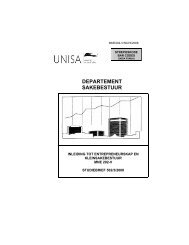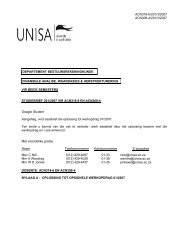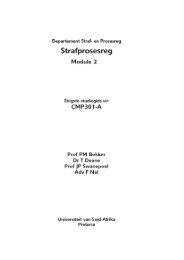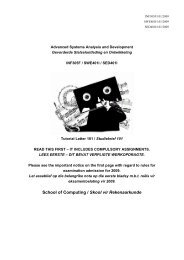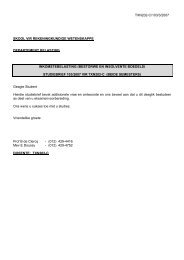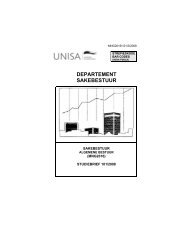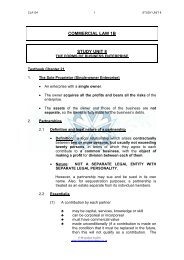Tutorial Letter 101 / Studiebrief 101 School of Computing ... - Name
Tutorial Letter 101 / Studiebrief 101 School of Computing ... - Name
Tutorial Letter 101 / Studiebrief 101 School of Computing ... - Name
You also want an ePaper? Increase the reach of your titles
YUMPU automatically turns print PDFs into web optimized ePapers that Google loves.
Advanced Systems Analysis and Development<br />
Gevorderde Stelselontleding en Ontwikkeling<br />
INF305F/SED401I/SWE401I<br />
<strong>Tutorial</strong> <strong>Letter</strong> <strong>101</strong> / <strong>Studiebrief</strong> <strong>101</strong><br />
<strong>School</strong> <strong>of</strong> <strong>Computing</strong> / Skool vir Rekenaarkunde<br />
INF305F/SED401I/SWE401I/<strong>101</strong>/0/2010<br />
inf305@osprey.unisa.ac.za<br />
http://www.osprey.unisa.ac.za<br />
https://my.unisa.ac.za/portal
Important notice:<br />
Since 2005 the national Department <strong>of</strong> Education has required that in order to be considered for<br />
examination admission a learner must submit at least one assignment before 30 June 2010.<br />
Belangrike nota:<br />
2<br />
Vanaf 2005 vereis die nasionale Departement van Opvoeding dat, om vir eksamentoelating in aanmerking<br />
te kom, 'n student ten minste een werkopdrag voor 30 Junie 2010 moet indien.<br />
To all Afrikaans speaking learners / Aan alle Afrikaanssprekende leerders:<br />
Hierdie studiebrief is slegs in Engels beskikbaar. Indien u sukkel om sekere dele van die inhoud te verstaan,<br />
kontak gerus u dosente.<br />
ASSIGNMENT DUE DATE NOTICE<br />
Assignment 1 - Multiple-choice 03 May 2010<br />
Used for exam admission.<br />
INF305F: 860733 SED401I: 216939 SWE401I: 313044<br />
Assignment 2 – Theory 05 July 2010 Used for year mark calculation.<br />
Assignment 3 – Self-evaluation <strong>Tutorial</strong> <strong>Letter</strong> 102<br />
Used for exam preparation by learner<br />
him/herself.
3<br />
Contents<br />
INF305F/SED401I/SWE401I/<strong>101</strong><br />
1 INTRODUCTION ................................................................................................................................. ........................ 5<br />
2<br />
3<br />
ABOUT THIS MODULE ............................................................................................................................................. 5<br />
COMMUNICATION WITH UNISA AND FELLOW LEARNERS ........................................................................ 5<br />
3.1 WHO TO PHONE FOR<br />
WHAT? ................................................................................................................................... 5<br />
3.2 COMMUNICATION CHANNELS<br />
................................................................................................................................. 6<br />
3.3 INTERNET ACCESS TO ON-LINE MATERIAL AND DISCUSSION FORUM ....................................................................... 6<br />
3.4 DISCUSSION FORUM ................................................................................................. .............................................. 7<br />
3.5 E-MAIL ................................................................................................................................................................... 7<br />
3.6 PHONE CALLS ......................................................................................................................................................... 8<br />
3.7 NO FAXING PLEASE ................................................................................................................................................ 8<br />
3.8 WRITTEN COMMUNICATION .............................................................................................................................. ..... 8<br />
3.9 COMMUNICATION WITH OTHER MODULE LEARNERS ............................................................... ............................... 9<br />
4 ISSUES PERTAINING TO THIS MODULE ............................................................................................................. 9<br />
5<br />
6<br />
7<br />
4.1 PREREQUISITE SKILLS ............................................................................................................................................ 9<br />
4.2 CO-OPERATIVE LEARNING (GROUP WORK) ............................................................................................................ 9<br />
STUDY MATERIAL ..................................................................................................................................................... 9<br />
5.1 PRESCRIBED TEXTBOOK ......................................................................................................................................... 9<br />
5.2 TUTORIAL LETTER 102 ........................................................................................................................................... 9<br />
STUDY MATTERS ..................................................................................................................................................... 10<br />
6.1 SYLLABUS ............................................................................................................................................................ 10<br />
EXAMINATION MATTERS ..................................................................................................................................... 10<br />
7.1 ENQUIRIES ABOUT DATES AND VENUE S ........................ ......... ..................... .......................................................... 10<br />
7.2 A SPECIAL EXAMINATION TUTORIAL LETTER ........................................................................................................ 11<br />
7.3 EXAMINATION ADMISSION .... .......... ............................... ....... ............................................................................... 11<br />
8 FREQUENTLY ASKED Q UESTIONS ............................. ........ .................................................................. ............. 11<br />
8.1 I CANNOT FIND THE TEXTBOOK ............................................................................................................................ 11<br />
8.2 I HAVE NOT RECEIVED CERTAIN S TUDY MATERIAL ............. ... ............................<br />
................................................... 11<br />
8.3 DOWNLOADING STUDY MATERIAL FROM THE WEB ............................................................................................... 11<br />
8.4 I WANT TO FORM A STUDY GROUP - WHERE DO I FIND THE OTHER LEARNERS? ..................................................... 12<br />
8.5 WHEN DO I GET MY ASSIGNMENT BACK? ............................................................................................................. 12<br />
8.6 WHAT MARKS DID I GET FOR MY ASSIGNMENT? ................................................................................................... 12<br />
9 ASSIGNMENT MATTERS ........................................................................................................................................ 12<br />
9.1 DUE DATES ........................................................................................................................................................... 12
4<br />
9.2 STRUCTURE OF THE ASSIGNMENTS ....................................................................................................................... 13<br />
9.3 YEAR MARK ......................................................................................................................................................... 13<br />
9.4 MODEL SOLUTIONS .............................................................................................................................................. 13<br />
9.5 SUBMITTING AN ASSIGNMENT .............................................................................................................................. 13<br />
9.6 HAVE WE RECEIVED YOUR ASSIGNMENT? ............................................................................................................ 14<br />
9.7 RELATION BETWEEN ASSIGNMENTS AND THE EXAMINATION .............................................................................. 14<br />
ASSIGNMENT 1 ................................................................................................................................................................... 15<br />
ASSIGNMENT 2 ................................................................................................................................................................... 22
1<br />
Introduction<br />
5<br />
INF305F/SED401I/SWE401I/<strong>101</strong><br />
We present you with a comprehensive first tutorial letter to assist you in the best possible way to make<br />
sure that you<br />
have effective interaction with the lecturers for this module.<br />
2 About this module<br />
‘When computer s<strong>of</strong>tware succeeds - when it meets the needs <strong>of</strong> the people who use it, when it<br />
performs<br />
flawlessly over a long period <strong>of</strong> time, when it is easy to modify and even easier to use - it can<br />
and<br />
does change things for the better. But when s<strong>of</strong>tware fails - when its users are dissatisfied, when it<br />
is error prone, when it is difficult to change and even harder to use - bad things can and do happen<br />
(Pressman,<br />
2010)’.<br />
This<br />
is the opening paragraph <strong>of</strong> the prescribed book, S<strong>of</strong>tware Engineering, A Practitioner’s Approach<br />
by<br />
Pressman, and summarizes the goal <strong>of</strong> this module - looking at the actions involved in building and<br />
maintaining<br />
s<strong>of</strong>tware from a S<strong>of</strong>tware Engineering approach.<br />
Prescribing<br />
a relevant, usable, user-friendly, affordable textbook is a particularly difficult task. We<br />
went<br />
through a number <strong>of</strong> books during 2004 in search <strong>of</strong> a prescribed book that addresses the<br />
important<br />
issues in S<strong>of</strong>tware Engineering and we finally decided on Roger S. Pressman’s book. He is a<br />
well-known<br />
author in this specific application domain and we believe that the learners taking this<br />
module<br />
will gain not only from the chapters that we cover in depth, but also from the chapters that we<br />
designate<br />
as reading material.<br />
We<br />
trust that you will find the module interesting and enriching!<br />
3 Communication with Unisa and fellow learners<br />
3.1 Who to phone for what?<br />
When you register, you should have received an inventory letter containing information about your<br />
tutorial matter. See also the brochure entitled Your Service Guide @ Unisa (which you received with<br />
your tutorial matter). Consult this document for the necessary contact people. Please do not telephone<br />
the lecturers for services supplied by support departments. In respect to all administrative enquiries<br />
only the UCC (Unisa Contact Centre) telephone and fax must be used. Enquiries will then be<br />
channelled to the respective Departments.
6<br />
• Calls – RSA only:<br />
0861 670 411<br />
• International Calls:<br />
+27 11 670 9000<br />
• Fax Number: (012) 429 4150 / +27 12 429 4150<br />
• Email: study-info@unisa.ac.za<br />
• The Lecturers for this module<br />
COMMUNICATION WITH THE UNIVERSITY<br />
Always have your student number<br />
at hand when you call the University.<br />
COS-ALL/2010<br />
3.2 Communication channels<br />
To increase the efficiency <strong>of</strong> managing this module, we have prioritized our communication channels.<br />
Too much time is <strong>of</strong>ten wasted on inefficiency, where a learner has to call Unisa repeatedly, or has to<br />
hold on until he or she<br />
gets through to the right person, before finally resolving the query he or she had.<br />
By<br />
placing a priority on the communication channel, we provide a guarantee <strong>of</strong> a rapid response time.<br />
In the following table, we list the available communication channels in order <strong>of</strong> highest to lowest<br />
priority and then discuss each one in the subsequent paragraphs.<br />
Channel Advantages General response time<br />
Discussion<br />
forum<br />
Transparency - learners <strong>of</strong>ten experience the same types <strong>of</strong> problems and if a<br />
query is placed on the discussion forum, everybody has access to the question as<br />
well as its answer<br />
Internet Access Much <strong>of</strong> the material that is available in printed form is available ‘much sooner’<br />
on the web for downloading.<br />
E-mail Please use the module<br />
e-mail address. Do not send mail to lecturers directly. Within 2 working days<br />
Telephone<br />
Written letters 2 - 6 weeks<br />
Within 2 working days<br />
Immediately<br />
Immediately only if the<br />
lecturer is not currently busy<br />
with another appointment<br />
such as a learner or a meeting<br />
or a workshop or a seminar or<br />
a conference or examining a<br />
learner, etc.<br />
3.3 Internet access to on-line material and discussion forum<br />
We have a departmental web server that is used as Internet access for learners enrolled for Computer<br />
Science or Information System modules. It is also accessible through the addresses<br />
http://osprey.unisa.ac.za,<br />
http://it.unisa.ac.za, or<br />
http://cs.unisa.ac.za.
7<br />
INF305F/SED401I/SWE401I/<strong>101</strong><br />
To access the discussion forums, click on the Registered Learner tab, click on your<br />
modules, submit,<br />
refresh the screen and the di scussion forum will be on your left-hand side. The login and access code<br />
for 2010 will be given in a general tutorial letter to learners but<br />
it could be:<br />
Login: MYDOWNLOAD<br />
Password: SOC2010<br />
During January 2011 the login/password combination for downloads will change from<br />
MYDOWNLOAD/SOC2010 to something new.<br />
Thus, 2010 material may no longer be<br />
available for download in January 2011. You must therefore ensure that<br />
you have<br />
downloaded all the material you may require for supplementary examinations by 30<br />
November 2010!!<br />
Unisa also has other web servers. An important one is the myUnisa server. This server is one <strong>of</strong> the<br />
Unisa servers that provide learner administration services, where you can do electronic submissions <strong>of</strong><br />
assignments, or check your records, etc. All tutorial letters for this module will be available on myUnisa<br />
the moment that they are sent to Despatch for distribution.<br />
3.4<br />
Discussion forum<br />
In this module we will use the discussion forum that can be found on the IT server for module-related<br />
matters.<br />
We use the discussion forum as our MAIN communication channel. Please access<br />
it regularly (once a<br />
week is fine). To access the discussion forum for this module, you must set up your browser only once.<br />
T he procedure is the same as the one described in section 3.3. The first time tha t you go to the<br />
departmental web site, go to:<br />
osp rey.unisa.ac.za,<br />
click o n the Registered<br />
Student tab,<br />
click on your modules,<br />
submit,<br />
refresh the screen<br />
and the discussion forum will be on your left-hand side.<br />
3.5<br />
E-mail<br />
We urgently request that you use the discussion forum for all electronic communication. There are<br />
different threads in the discussion forum. Please use it to direct all your queries. Please<br />
use the<br />
module discussion forum instead <strong>of</strong> the module e-mail.
8<br />
Reserve your e-mail messages for highly personal matters. The e-mail address for this module is<br />
inf305@osprey.unisa.ac.za - please put your student number and module number next to the subject-<br />
line, otherwise it may be deleted as spam.<br />
Please do not use the personal e-mail addresses <strong>of</strong> the lecturing staff. The above address will ensure<br />
that your e-mail will be<br />
answered even if a particular lecturer is not available.<br />
3.6 Phone<br />
calls<br />
Please consult your tutorial letters first to see whether we have not already addressed your<br />
queries.<br />
Since most learners experience the same problems, we address the most common problems<br />
in the<br />
tutorial letters.<br />
Remember<br />
that we are sometimes not available due to other departmental or university duties. If you<br />
fail to reach us directly, please call the departmental secretary for she will be able to inform you about<br />
when we will be available, or she will take a message, in which case you should leave a message<br />
stating the reason for your call and your name, student number and telephone number. The<br />
departmental secretary’s number is (012) 429-6122.<br />
3.7 No faxing please<br />
Due to the high cost, our <strong>School</strong> has a policy <strong>of</strong> not faxing material to learners. However, we do get<br />
quite a number <strong>of</strong> learners faxing us regarding requests for extensions on certain study material, etc.,<br />
and requesting<br />
us to contact them in return. Facsimiles place an unnecessary administrative burden on<br />
the<br />
staff since there is only one fax machine in the <strong>of</strong>fice <strong>of</strong> a secretary. However, each lecturer has an<br />
e-mail facility on his/her desk. With large modules, the burden simply becomes too large to carry if the<br />
lecturers have to go looking for faxes. Please, if you need to contact us urgently, use the discussion<br />
forum or e-mail.<br />
3.8 Written communication<br />
Please mention your student number in all<br />
written communication. All academic matters can be<br />
addressed to:<br />
The Registrar<br />
UNISA<br />
P O Box 392<br />
PRETORIA<br />
0003<br />
<strong>Letter</strong>s on any aspects regarding the module should be addressed as follows:<br />
The Lecturer (INF305F) or (SED401I) or (SWE401I)<br />
<strong>School</strong> <strong>of</strong> <strong>Computing</strong><br />
UNISA<br />
P.O. Box 392<br />
PRETORIA<br />
0003
9<br />
INF305F/SED401I/SWE401I/<strong>101</strong><br />
3.9 Communication with other module learners<br />
Phone the Unisa Contact Centre and ask for a list <strong>of</strong> learners <strong>of</strong> this module in your environment, or<br />
join our discussion forum and start communicating with other learners.<br />
4 Issues pertaining to this module<br />
4.1 Prerequisite skills<br />
Learners enrolled for this module must have a background in systems analysis and design obtained<br />
through previous undergraduate module work.<br />
4.2 Co-operative learning (Group Work)<br />
In this module you may work in groups, BUT each person must submit his or her own assignment.<br />
Take note that all members <strong>of</strong> a group cannot submit a copy <strong>of</strong> the same assignment, but each<br />
person<br />
must submit his or her own assignment, using his or her<br />
own words to describe the solution. If you<br />
work in a group, it is important<br />
to say who worked together, so that we can evaluate submitted<br />
assignments in that light.<br />
5 Study material<br />
5.1 Prescribed textbook<br />
The following textbook<br />
(referred to as Pressman in the remaining text), is prescribed for this module:<br />
S<strong>of</strong>tware Engineering: A Practitioner’s Approach, Roger S. Pressman, Seventh Edition, International<br />
Edition 2010, McGraw Hill<br />
• ISBN: 978-007-126782-3<br />
• PLEASE buy the book<br />
as soon as you register for the module. More than one university prescribes<br />
the book and if you wait, you will probably not find a copy.<br />
• We recommend that you first phone the list <strong>of</strong> bookstores (in Your Service Guide @ Unisa) to get the<br />
local price for the book before using an on-line store.<br />
• Please consult<br />
the list <strong>of</strong> <strong>of</strong>ficial booksellers and their addresses in Your Service Guide @ Unisa.<br />
• If you have any difficulties with obtaining books from these bookshops, contact the Contact Centre<br />
at 0861 670 411 (South Africa) or +27 11 670 9000 (Internationally), or send<br />
an e-mail to<br />
vospresc@unisa.ac.za<br />
• Important note: No assignment<br />
can be done without the prescribed book.<br />
5.2 <strong>Tutorial</strong><br />
letter 102<br />
We do not wish to burden you with much MORE reading material than that which is already accessible<br />
in the textbook. We include a self-study assignment in <strong>Tutorial</strong> <strong>Letter</strong> 102, to help with the<br />
examination<br />
preparation.
6 Study matters<br />
10<br />
6.1 Syllabus<br />
We use the textbook and additional material that we will<br />
send out in the form <strong>of</strong> tutorial letters.<br />
The 7th edition <strong>of</strong> S<strong>of</strong>tware Engineering: A Practitioner's<br />
Approach contains 32 chapters organized<br />
into<br />
five parts. The book comprises approximately 900 pages. For this module, only the following will<br />
be covered:<br />
Chapter Heading Comments<br />
Chapter 1: S<strong>of</strong>tware & S<strong>of</strong>tware Engineering Read<br />
Chapter 2: Process Models Study<br />
Chapter 3: Agile Development Study<br />
Chapter 4: Principles that Guide Practise Study<br />
Chapter 5: Understanding Requirements Study<br />
Chapter 6: Requirements Modeling Read<br />
Chapter 8: Design Concepts Study<br />
Chapter 9: Architectural Design Read<br />
Chapter 10: Component-Level Design Study<br />
Chapter 11: User Interface Design Read<br />
Chapter 12: Pattern-Based Design Read<br />
Chapter 13: WebApp Design Read<br />
Chapter 17: S<strong>of</strong>tware Testing Strategies Study<br />
Chapter 18: Testing Conventional Applications Study<br />
Chapter 19: Testing Object-Oriented Applications Study<br />
Chapter 20: Testing Web Applications Read<br />
7 Examination matters<br />
7.1 Enquiries about dates and venues<br />
U nisa is an enormous institution and we, the lecturers, have nothing to do with examinations except for<br />
setting the paper - long before October / November - and receiving the papers afterwards for marking.<br />
We can therefore not give you any relevant information regarding examination<br />
dates or venues. Please<br />
contact the Contact Centre for examination details. Take note <strong>of</strong> the dates <strong>of</strong> your examinations and<br />
arrange with your employer for<br />
leave in good time. Check that there are no clashes on your<br />
examination timetable. Should there be any such clashes, kindly inform the Contact Centre without<br />
delay or Examination Administration (e-mail: exams@unisa.ac.za).
11<br />
INF305F/SED401I/SWE401I/<strong>101</strong><br />
7.2 A special examination tutorial letter<br />
A special examination tutorial letter will be sent to you informing you about any issues regarding the<br />
paper. This includes<br />
matters such as the format <strong>of</strong> the paper.<br />
7.3 Examination admission<br />
You gain admission to the examination by submitting one assignment before 30 June 2010. Note that<br />
this assignment must be done satisfactorily. For a written assignment or answer you may not submit<br />
just<br />
one or two sentences. For assignments in multiple-choice format, you may not submit an empty<br />
assignment – you have to select an answer for each question. For your year mark (see section<br />
9.3) you<br />
need to submit<br />
Assignment 2.<br />
8 Frequently asked questions<br />
There are several reasons why you may<br />
wish to contact Unisa and too <strong>of</strong>ten you are put on hold and<br />
h ave to go from one person to another before you finally reach the correct person. Therefore, in this<br />
section, we provide a list <strong>of</strong> common reasons why learners contact us and<br />
information on how to<br />
address these problems in the most efficie nt and quickest possible way.<br />
8.1 I cannot find the textbook<br />
PRESSMAN is a very popular book and more than one university pre scribes it. Please buy the book as<br />
soon as possible to ensure that you do not have difficulty in obtaining the book later on.<br />
D o not contact the lecturers for this module if you have problems obtaining the textbook.<br />
U nfortunately we cannot help with the availability <strong>of</strong> textbooks since we have no contact with the book<br />
dealers. Use the following guidelines if you experience difficulty in obtaining a textbook:<br />
1. If your university book dealer does not have the book in stock, ask them to put your name<br />
on their order list so that they can contact you as soon as the new stock arrives.<br />
2. If your university book dealer<br />
cannot help you, call the Contact Centre for further advice.<br />
Never send in a sub-standard assignment<br />
because you do not have the prescribed book. You<br />
cannot and will not receive marks for not doing work because<br />
you do not have a book!<br />
8.2 I have not received certain study material<br />
Printed material is only distributed by the Despatch Department. Unfortunately our <strong>School</strong> does not<br />
have the facilities to fax copies <strong>of</strong> any study material. You can also visit our WEB site<br />
(osprey.unisa.ac.za) and download the specific material if it is available (see section 3.3).<br />
8.3 Downloading study material from the web<br />
Please note that:
• Due to copyright regulations, we will not necessarily place all the material on the web.<br />
12<br />
• The material placed on the web will be in PDF-format. Please download the PDF-reader from<br />
our WEB site and install it on your machine (once).<br />
All tutorial letters should be downloada<br />
for distribution.<br />
ble from myUnisa the moment that we send them to Dispatch<br />
8.4 I want to form a study group - where do I find the other learners?<br />
The lecturers may not distribute any personal information about any learner. However, on the<br />
registration form that each learner<br />
fills in at the beginning <strong>of</strong> the academic year/term, the university<br />
requires<br />
to know whether or not the university may distribute the learner’s contact details to other<br />
learners. This information is available via the Contact Centre. If you need contact information about<br />
other learners in your area, the Contact Centre can<br />
assist you in obtaining the necessary information.<br />
8.5<br />
When do I get my assignment back?<br />
Turnaround time for marking is commonly between 4 and 5 weeks. If you have not received your<br />
assignment back after this time, please read the discussion forum to see if any delays are being<br />
experienced, or phone the Contact Centre.<br />
8.6 What marks did I get for my assignment?<br />
As soon as your assignment is marked the mark will be displayed on the myUnisa system. Usually the<br />
multiple-choice assignment marks are available 2-3 weeks after the due date. The written assignments<br />
may take longer.<br />
9 Assignment matters<br />
There are three assignments for this module. To gain examination admission you need to complete and<br />
submit assignment 01. We do advise you to complete all the assignments so as to cover the content<br />
matter<br />
before the examinations.<br />
9.1<br />
Due dates<br />
ASSIGNMENT<br />
Assignment 1 - Multiple-choice 03 May 2010<br />
DUE DATE NOTICE<br />
Used for exam admission.<br />
INF305F: 860733 SED401I: 216939 SWE401I: 313044<br />
Assignment 2 – Theory 05 July 2010 Used for year mark calculation.<br />
Assignment 3 – Self-evaluation <strong>Tutorial</strong> <strong>Letter</strong> 102<br />
Used for exam preparation by learner<br />
him/herself.
9.2 Structure <strong>of</strong> the assignments<br />
Multiple-choice assignments<br />
13<br />
INF305F/SED401I/SWE401I/<strong>101</strong><br />
Assignment 01 is a multiple-choice assignment, which should either be completed on the computer<br />
mark-reading sheet issued to you during registration, or be submitted electronically through myUnisa.<br />
The multiple-choice<br />
assignment is marked electronically on a predetermined date. For example, if the<br />
submission date for a particular assignment is 03 May and the scheduled marking date is 03 May, then<br />
all submitted assignments will be marked through batch processing by the computer one or two days<br />
after the due date.<br />
Written assignments<br />
Assignment 2 and 3 are written assignments. Assignment 2 should be posted to Unisa or uploaded on<br />
the myUnisa web site. Assignment 2 is used to determine your year mark. Assignment 3 is for selfevaluation<br />
and can be used to provide additional examples in your preparation for the November and/or<br />
January examinations.<br />
9.3 Year mark<br />
Each module leader may decide which assignments<br />
will count towards the year mark. For<br />
INF305F/SED401I/SWE401I you will receive a possible mark out <strong>of</strong> 10, which will count towards<br />
your final mark for the year. For this module, we will use the mark<br />
that you receive for Assignment 02.<br />
9.4 Model solutions<br />
Model solutions will<br />
be posted to the module web site two to three weeks after the due date <strong>of</strong> each<br />
assignment. A single printed version <strong>of</strong> solutions will also be sent to learners.<br />
9.5 Submitting an assignment<br />
You can submit your assignments in several ways.<br />
1. electronically through the myUnisa server,<br />
2. by postal mail,<br />
3. By placing them in one <strong>of</strong> Unisa’s assignment<br />
boxes.<br />
Postal or assignment-box<br />
submission <strong>of</strong> an assignment<br />
1. Complete your assignment and place it in an assignment<br />
cover provided during registration.<br />
2. Put your assignment in an envelope and submit the assignment using the postal mail<br />
or one <strong>of</strong><br />
Unisa’s assignment mail boxes.<br />
Electronic submission <strong>of</strong> an assignment<br />
1. Click on the electronic submission<br />
link on myUnisa<br />
for INF305F (or for SED401I) (or for<br />
SWE401I) and complete your answers on the sheet<br />
provided for the applicable<br />
assignment.<br />
2.<br />
Upload your assignment.
14<br />
9.6 Have we received your assignment?<br />
If you used myUnisa to upload your assignment, you should immediately see that the assignment is on<br />
the system, next to the applicable<br />
assignment in the assignment list. If not, re-enter your answers. If you<br />
used the postal system check myUnisa two to three days after submitting your assignment. If it is not on<br />
the system, resubmit your assignment. Always keep copies <strong>of</strong> your answers so as to be able to give us<br />
a copy in case something goes wrong.<br />
It is your responsibility to check if your assignment was received by Unisa or not. We will be lenient<br />
with problems up until<br />
one week after the due date. After this date we will not consider any pleas<br />
regarding<br />
lost assignments.<br />
9.7 Relation between Assignments and the Examination<br />
Our assignments are designed with at least two goals in mind:<br />
1. to make sure that you actually go through the work during the year and do not try to do it all in<br />
the week before the examinations (this is accomplished through the multiple-choice questions<br />
given to you in the assignments).<br />
2. to teach you how<br />
to think and argue critically on issues in this module.
15<br />
INF305F/SED401I/SWE401I/<strong>101</strong><br />
Assignment 1 Total: 100<br />
Submission Date: 03 May 2010<br />
Prescribed work: Chapters: 1-6, 8-13, 17-20 Speed-read and answer these questions<br />
Unique Number: INF305F: 860733 SED401I: 216939 SWE401I: 313044<br />
Chapter 2<br />
1. Which <strong>of</strong> the following are<br />
recognized process flow types?<br />
1. Concurrent process flow and Linear process flow<br />
2. Iterative process flow and Linear process flow<br />
3. Linear process flow and Spiral process flow<br />
4. Spiral process flow and Concurrent process flow<br />
2. S<strong>of</strong>tware processes can be constructed<br />
out <strong>of</strong> pre-existing s<strong>of</strong>tware patterns to best meet the needs<br />
o f a s<strong>of</strong>tware project.<br />
1. True<br />
2. False<br />
3. Which <strong>of</strong> these are standards for assessing s<strong>of</strong>tware processes?<br />
1. SEI and ISO 9000<br />
2. SPICE and ISO 9001<br />
3. ISO 9000 and SPICE<br />
4. ISO 9001 and SEI<br />
4. The waterfall model <strong>of</strong> s<strong>of</strong>tware development is<br />
1. a reasonable approach when requirements are well defined.<br />
2. a good approach when a working program is required quickly.<br />
3. the best approach to use for projects with large development teams.<br />
4. an old fashioned model that is rarely used any more.<br />
5. The incremental model <strong>of</strong> s<strong>of</strong>tware development is<br />
1. a reasonable approach when requirements are well defined.<br />
2. a good approach when a working core product is required quickly.<br />
3. the best approach to use for projects with large development teams.<br />
4. a revolutionary model that is not used for commercial products.
6. Evolutionary s<strong>of</strong>tware process models<br />
16<br />
1. are iterative in nature?<br />
2. can easily accommodate product requirements<br />
changes?<br />
3. do not generall y produce throwaway<br />
systems?<br />
4. All <strong>of</strong> the abov e.<br />
Chapter<br />
3<br />
7.<br />
Agility is nothing more than the ability <strong>of</strong> a project team to respond rapidly to change.<br />
1.<br />
True<br />
2. False<br />
8. Which <strong>of</strong> the following is not necessary to apply agility<br />
to a s<strong>of</strong>tware process?<br />
1. Eliminate the use <strong>of</strong> project planning and testing<br />
2. Only essential work products are produced<br />
3. Process allows team to streamline tasks<br />
4. Uses incremental product delivery strategy<br />
9. How do you<br />
create agile processes to manage unpredictability?<br />
1. Requirements gathering must be conducted very carefully and<br />
risk analysis must be conducted<br />
before planning takes place.<br />
2. Risk analysis must be conducted before planning takes place and s<strong>of</strong>tware increments must be<br />
delivered in short time<br />
periods.<br />
3. S<strong>of</strong>tware increments must<br />
be delivered in short time periods and s<strong>of</strong>tware processes must adapt<br />
to changes incrementally.<br />
4. Requirements gathering<br />
must be conducted very carefully and s<strong>of</strong>tware processes must adapt to<br />
changes incrementally.<br />
10. In agile s<strong>of</strong>tware processes the highest priorities is to satisfy the customer<br />
through early and<br />
continuous delivery <strong>of</strong> valuable s<strong>of</strong>tware.<br />
1. True<br />
2. False<br />
11. Which one <strong>of</strong> the following traits needs to exist among the members<br />
<strong>of</strong> an agile s<strong>of</strong>tware team?<br />
1. Competence<br />
2. Decision-making ability<br />
3. Mutual trust and respect<br />
4. All <strong>of</strong> the above<br />
12. In agile development, it is more important to build s<strong>of</strong>tware that meets the customers’ needs<br />
today than worry about features that might be needed in the future.
1. True<br />
2. False<br />
Chapter 4<br />
13. S<strong>of</strong>tware engineering principles have about a three-year half-life.<br />
1. True<br />
2. False<br />
17<br />
INF305F/SED401I/SWE401I/<strong>101</strong><br />
14. Which <strong>of</strong> the following is not one <strong>of</strong> the core principles <strong>of</strong> s<strong>of</strong>tware engineering practice?<br />
1.<br />
All design should be as simple as possible, but no simpler.<br />
2. A s<strong>of</strong>tware system exists only to provide value to its users.<br />
3. Pareto principle (20% <strong>of</strong> any product requires 80% <strong>of</strong> the effort).<br />
4. Remember what you produce others will consume.<br />
15. Every communication activity should have a<br />
allowed to dominate the proceedings.<br />
1. True<br />
2. False<br />
facilitator to make sure that the customer is not<br />
16. The agile view <strong>of</strong> iterative customer communication and collaboration is applicable to all s<strong>of</strong>tware<br />
engineering practice.<br />
1. True<br />
2. False<br />
17. One<br />
reason to involve everyone<br />
1. adjust the granularity <strong>of</strong> the plan.<br />
2. control feature creep.<br />
3. get all team members to “sign up” to the plan.<br />
4. understand<br />
the problem scope.<br />
on the s<strong>of</strong>tware team in the planning activity is to<br />
18.<br />
Project plans should not be changed once they are adopted by a team.<br />
1. True<br />
2. False<br />
Chapter 5<br />
19. Requirements engineering is a generic process that does not vary from one s<strong>of</strong>tware project to<br />
another.
1. True<br />
2. False<br />
20. During project<br />
inception the intent <strong>of</strong> the tasks are to determine<br />
1. basic problem understanding.<br />
2. nature <strong>of</strong> the solution needed.<br />
3. people who want a solution.<br />
4. All <strong>of</strong> the above.<br />
21. Three things that make requirements elicitation difficult are problems <strong>of</strong><br />
1. Budgeting, scope and understanding.<br />
2. scope, understanding and volatility.<br />
3. understanding, volatility and budgeting.<br />
4. volatility, budgeting and scope.<br />
22. A stakeholder is anyone who will purchase the completed s<strong>of</strong>tware system under development.<br />
1. True<br />
2. False<br />
18<br />
23.<br />
It is relatively common for different customers to propose conflicting requirements, each arguing<br />
that his or her version is the right one.<br />
1. True<br />
2. False<br />
Chapter<br />
8<br />
24. Which<br />
<strong>of</strong> the following are areas <strong>of</strong> concern in the design model?<br />
1. Architecture, data and interfaces.<br />
2. Data, interfaces and project scope.<br />
3. Interfaces, project scope and architecture.<br />
4. project scope, architecture and data.<br />
25.<br />
The importance <strong>of</strong> s<strong>of</strong>tware design can be summarized in a single word.<br />
1. accuracy<br />
2. complexity<br />
3. efficiency<br />
4. quality<br />
26. Which <strong>of</strong><br />
these are characteristics <strong>of</strong> a good design?
19<br />
INF305F/SED401I/SWE401I/<strong>101</strong><br />
1. Exhibits strong coupling between its modules and implements all requirements in the analysis<br />
model.<br />
2. Implements all requirements in the analysis model and provides a complete picture <strong>of</strong> the<br />
s<strong>of</strong>tware.<br />
3. Includes test cases for all components and implements all requirements in the analysis model.<br />
4. Provides a complete picture <strong>of</strong> the s<strong>of</strong>tware and includes test cases for all components.<br />
27. Which <strong>of</strong> the following is not a characteristic<br />
common to all design methods?<br />
1. configuration<br />
management<br />
2. functional component representation<br />
3. quality assessment guidelines<br />
4. refinement heuristics<br />
28. What types <strong>of</strong> abstraction are used in s<strong>of</strong>tware<br />
design?<br />
1. Control, data and procedural.<br />
2. Data, environmental and control.<br />
3. Environmental, procedural and data.<br />
4. Procedural,<br />
control and environmental.<br />
29. Which<br />
<strong>of</strong><br />
the following can be used to represent the architectural design <strong>of</strong> a piece <strong>of</strong> s<strong>of</strong>tware?<br />
1. Dynamic models<br />
2. Functional models<br />
3. Structural models<br />
4. All <strong>of</strong> the above<br />
Chapter<br />
10<br />
30.<br />
In the most general sense, a component is a modular building block for computer s<strong>of</strong>tware.<br />
1. True<br />
2. False<br />
31. In the context <strong>of</strong> object-oriented s<strong>of</strong>tware engineering<br />
a component contains<br />
1. attributes and operations.<br />
2. instances <strong>of</strong> each class.<br />
3. roles for each actor (device or user).<br />
4. set <strong>of</strong> collaborating<br />
classes.<br />
32. In traditional s<strong>of</strong>tware<br />
engineering, modules must serve in which <strong>of</strong> the following roles?<br />
1. Control component<br />
2. Infrastructure component
3. Problem domain component<br />
4. All <strong>of</strong> the above<br />
33. S<strong>of</strong>tware engineers always need to create components from scratch in order to meet customer<br />
expectations fully.<br />
1. True<br />
2. False<br />
34.<br />
Which <strong>of</strong> the following is not one <strong>of</strong> the four principles used to guide component-level design?<br />
1. Dependency Inversion Principle<br />
2. Interface Segregation Principle<br />
3. Open-Closed Principle<br />
4. Parsimonious Complexity Principle<br />
35.<br />
The use <strong>of</strong> stereotypes can help identify the nature <strong>of</strong> components at the detailed design level.<br />
1. True<br />
2. False<br />
Chapter 17<br />
36. In s<strong>of</strong>tware quality assurance<br />
work there is no difference between s<strong>of</strong>tware verification and<br />
s<strong>of</strong>tware validation.<br />
1. True<br />
2. False<br />
37.<br />
The best reason for using Independent s<strong>of</strong>tware test teams<br />
is that<br />
1. s<strong>of</strong>tware developers do not need to do any testing.<br />
2. strangers<br />
will test the s<strong>of</strong>tware mercilessly.<br />
3. testers do not get involved with the project until testing begins.<br />
4. the conflicts<br />
<strong>of</strong> interest between developers and testers is reduced.<br />
38. What is the normal order <strong>of</strong> activities in which traditional s<strong>of</strong>tware testing is organized?<br />
a. integration testing b. system testing c. unit testing d. validation testing<br />
1. c, a, d, b<br />
2. d, c, a, b<br />
3. c, b, a, d<br />
4.<br />
a, c, b, d<br />
20<br />
39.<br />
By collecting s<strong>of</strong>tware metrics and making use <strong>of</strong> existing s<strong>of</strong>tware reliability models it is possible<br />
to develop meaningful guidelines<br />
for determining when s<strong>of</strong>tware testing is done.
1. True<br />
2. False<br />
21<br />
INF305F/SED401I/SWE401I/<strong>101</strong><br />
40. Which <strong>of</strong> the following strategic issues needs to be addressed in a successful s<strong>of</strong>tware testing<br />
process?<br />
1. Conduct formal technical reviews prior to testing and specify requirements in a quantifiable<br />
manner.<br />
2. Specify<br />
requirements in a quantifiable manner and use independent test teams.<br />
3. Use independent test teams and wait till code is written prior to writing the test plan.<br />
4. Wait till code is written prior to writing the test plan and conduct formal technical reviews prior<br />
to testing.<br />
Chapter 18<br />
41. With thorough testing, it is possible to remove<br />
all defects from a program prior to delivery to the<br />
customer.<br />
1. True<br />
2. False<br />
42.<br />
Which <strong>of</strong> the following is a characteristic <strong>of</strong> testable s<strong>of</strong>tware?<br />
1. observability<br />
2. simplicity<br />
3. stability<br />
4. all <strong>of</strong> the above<br />
43. The testing technique that requires devising test cases to demonstrate that each program function is<br />
operational<br />
is called<br />
1. black-box testing.<br />
2. glass-box testing.<br />
3. grey-box testing.<br />
4. white-box testing.<br />
44. The<br />
testing technique that requires devising test cases to exercise the internal logic <strong>of</strong> a s<strong>of</strong>tware<br />
module is called<br />
1. behavioral testing.<br />
2. black-box testing.<br />
3. grey-box testing.<br />
4. white-box testing.<br />
45.<br />
What types <strong>of</strong> errors are missed by black-box testing and can be uncovered by white-box testing?<br />
1. behavioral errors and performance errors<br />
2. logic errors and typographical errors
3. performance errors and logic errors<br />
4. typographical<br />
errors and behavioral errors<br />
Chapter 19<br />
4 6. It is not possible to test object-oriented s<strong>of</strong>tware without including error discovery techniques<br />
applied to the system OOA and OOD models..<br />
1. True<br />
2. False<br />
22<br />
47. The correctness<br />
<strong>of</strong> the OOA and OOD model is accomplished using formal technical reviews by the<br />
s<strong>of</strong>tware quality assurance team.<br />
1. True<br />
2. False<br />
48. The consistency<br />
<strong>of</strong> object-oriented models may be judged by reviewing the CRC card model.<br />
1. True<br />
2. False<br />
49. Test case design for<br />
OO s<strong>of</strong>tware is driven by the algorithmic detail <strong>of</strong> the individual operations.<br />
1. True<br />
2.<br />
False<br />
50. Integration testing <strong>of</strong> object-oriented s<strong>of</strong>tware can be accomplished by which <strong>of</strong> the following<br />
testing strategies?<br />
1. Cluster testing, thread-based<br />
testing and use-based testing.<br />
2. Glass-box testing, use-based testing and cluster testing.<br />
3. Thread-based testing,<br />
cluster testing and glass-box testing.<br />
4. Use-based testing, glass-box testing and thread-based testing.<br />
Assignment 2<br />
Submission Date: 05 July 2010<br />
Prescribed<br />
work: Chapters: STUDY chapters 2, 3, 4, 5, 8, 10, 17, 18 and 19<br />
Total: 100<br />
Hint 1: This Assignment is long and will take a while to complete. After studying all the relevant<br />
chapters,<br />
plan at least one full week to do the assignment.<br />
Hint 2: Each question must be answered in a short<br />
essay type answer. Each answer should not be<br />
longer than 15 sentences.
23<br />
INF305F/SED401I/SWE401I/<strong>101</strong><br />
Chapter 2<br />
Question 01: The concurrent process model defines a set <strong>of</strong> ‘states’. Describe in your own words what<br />
these states represent,<br />
and then indicate how they come into play within the concurrent process model.<br />
[ 5]<br />
Question 02: What are the advantages and disadvantages <strong>of</strong> developing s<strong>of</strong>tware in which quality is<br />
‘good<br />
enough’? That is, what happens when we emphasize development speed over product quality?<br />
[7]<br />
Chapter 3<br />
Question<br />
03: Describe the XP concepts <strong>of</strong> refactoring and pair programming in your own words.<br />
[5]<br />
Question<br />
04: Why is Crystal called a family <strong>of</strong> agile methods? [5]<br />
Chapter 4<br />
Question<br />
05: Describe separation <strong>of</strong> concerns in your own words. [5]<br />
Question 06: How does agile communication differ from traditional s<strong>of</strong>tware engineering<br />
communication?<br />
How is it similar? [6]<br />
Chapter 5<br />
Question 07: Why is it that many s<strong>of</strong>tware developers don’t pay enough attention to requirements<br />
engineering?<br />
Are there ever circumstances where you can skip it? [6]<br />
Question 08: Why do we say that the requirements model represents a snapshot <strong>of</strong> a system in time?<br />
[5]<br />
Chapter 8<br />
]<br />
in your own words. [5]<br />
Question 09: If a s<strong>of</strong>tware design is not a program (and it isn’t), then what is it? [5<br />
Question<br />
10: Describe s<strong>of</strong>tware architecture<br />
Chapter 10<br />
Question 11: Why are control components necessary in traditiona<br />
in object-oriented s<strong>of</strong>tware?<br />
l s<strong>of</strong>tware and generally not required<br />
[5]<br />
Question 12: Why is chunking important during the component-level design review process? [5]<br />
Chapter 17<br />
Question 13: Is it always possible to develop a strategy for testing s<strong>of</strong>tware that uses the sequence <strong>of</strong><br />
testing steps described in Section 17.1.3? What possible complications might arise for embedded<br />
systems?<br />
Question 14: Why is a highly coupled module difficult to unit-test?<br />
Chapter 18<br />
Question 15: Can you think <strong>of</strong> any additional testing objectives that are not discussed in Section<br />
14.1.1?<br />
[5]<br />
[6]<br />
[5]
24<br />
Question 16: Give at least three examples in which black-box testing might give the impression that<br />
‘everything is OK’, while white-box tests might uncover an error. Give at least three examples in which<br />
white-box testing might give the impression that ‘everything is OK’, while black-box tests might<br />
uncover an error. [7]<br />
Chapter 19<br />
Question 17: Which is more valuable to object-oriented testing, white-box or black-box testing? Why?<br />
[8]<br />
Question 18:<br />
What is the difference between thread-based and use-based strategies for integration<br />
testing? How does cluster testing fit in? [ 5]<br />
©<br />
UNISA<br />
2009



